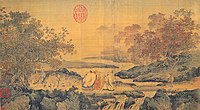
Back Drei Lehren German Tres enseñanzas Spanish Trois enseignements French Tridharma ID 三教 Japanese 삼교 Korean Tiga ajaran Malay De tre lærer NB Три учения Russian Üç öğreti Turkish




In Chinese philosophy, the three teachings (Chinese: 三教; pinyin: sān jiào; Vietnamese: tam giáo, Chữ Hán: 三教) are Confucianism, Taoism, and Buddhism. All of these three teachings are considered a harmonious aggregate.[1] Literary references to the "three teachings" by prominent Chinese scholars date back to the 6th century.[1] The term may also refer to a non-religious philosophy built on that aggregation.
- ^ a b "Living in the Chinese Cosmos: Understanding Religion in Late-Imperial China". afe.easia.columbia.edu.
© MMXXIII Rich X Search. We shall prevail. All rights reserved. Rich X Search